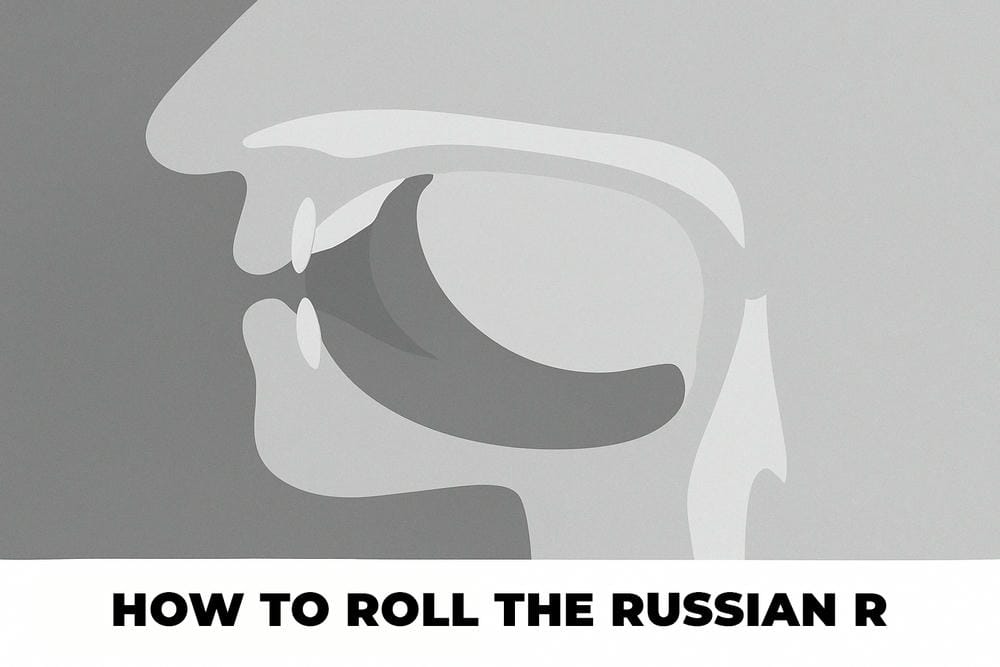Table of Contents
ToggleMastering the Russian Rolled R (Р/Рь)
Rolling your R, especially the Russian way, can feel intimidating at first, but with structured steps and daily practice, it’s absolutely achievable. This guide walks you through what, how, and why behind the Russian rolled R.
With this content that is meant for English speakers learning Russian expand on the topic and when helpful add examples or create a list of related Russian terms for an English speaker learning Russian on this topic which is the first H1. If you create a related Russian terms table then make sure you spell the words in Cyrillic, then English phonetic and a English definition
Rolling Your R: Mastering the Russian Trilled R
Rolling your R, or the trilled R, is a key part of sounding authentic in Russian. It might feel tricky at first because this sound doesn’t exist naturally in English for most speakers. But with the right approach and steady practice, you can learn to roll your R just like a native Russian speaker.
Why Is Rolling the R Important in Russian?
The rolled R is not just a fancy sound—it changes meanings. Russian has many words where the difference between a single R (like in English) and a rolled R can change the entire word. For example:
- Бор (bor) means “pine forest”
- Бур (bur) means “auger” or “drill”
If you don’t roll your R properly, you risk getting confused or misunderstood.
How to Roll Your R: Step-by-Step
1. Understand the Sound
The rolled R is a trill sound produced by the vibration of the tip of your tongue against the alveolar ridge (the ridge just behind your upper front teeth).
2. Practice Tongue Placement
- Place the tip of your tongue lightly against the alveolar ridge.
- It should be relaxed but firm enough to vibrate.
3. Start with a Motorboat Sound
Try making a sound like a motorboat or purring cat: “rrrrr.” This helps your tongue get used to the vibration.
4. Use Airflow
Push air out of your mouth steadily while keeping your tongue in position. The airflow will cause the tongue to vibrate, creating the rolled R.
5. Practice with Simple Sounds
Start by combining the rolled R with vowels:
- ра (ra)
- ре (re)
- ри (ri)
- ро (ro)
- ру (ru)
Repeat these sounds slowly, then gradually speed up.
Common Challenges and Tips
| Challenge | Tip |
|---|---|
| Tongue too stiff | Relax your tongue; it should be loose enough to vibrate. |
| No vibration | Increase airflow and try again with more breath pressure. |
| Tongue hitting teeth | Position your tongue slightly behind the teeth on the alveolar ridge. |
| Frustration | Practice a few minutes daily; consistency beats long sessions once in a while. |
Related Russian Terms with Rolled R
| Cyrillic | English Phonetic | English Definition |
|---|---|---|
| Река | Reh-KAH | River |
| Рыба | RIH-bah | Fish |
| Работа | Rah-BOH-tah | Work / Job |
| Радость | RAH-dost | Joy / Happiness |
| Роза | ROH-zah | Rose |
Practice saying these words aloud, focusing on rolling the initial “Р” sound.
Try the following techniques below to find the best way for you to roll your R’s.
🔹 Understanding the Russian Rolled R
Russian uses two rolled R sounds:
-
Hard R (р): Rolled at the alveolar ridge (just behind the upper teeth).
-
Soft R (рь): Rolled slightly further forward, right behind the front teeth, and is shorter and lighter in sound.
The difference is based on surrounding letters:
-
Use soft R before soft vowels (я, ё, ю, е, и) or the soft sign (ь).
-
Use hard R before hard vowels (а, о, у, ы, э), consonants, or at word endings.
🔹 Step-by-Step Learning Plan
Step 1: Get Familiar with Tongue Placement
-
Locate the alveolar ridge, the bumpy area behind your upper front teeth.
-
Place the tip of your tongue gently on this ridge.
-
Your tongue should be relaxed and slightly arched, ready to flap when air flows over it.
Step 2: Create the Vibration (Start the Engine)
-
Forcefully exhale air while the tongue lightly touches the ridge.
-
Imagine starting a little motor — if done right, your tongue will begin to flutter, making the classic rolled R sound.
-
It may help to try making a raspberry (motorboat) sound, transitioning from lips to tongue.
Step 3: Practice with Trigger Words and Phrases
🔸 The “Umbreon” Technique:
-
Say the word “Umbreon” and isolate the “BR” part.
-
Replace “BR” with a playful motorboat noise: “umon, umon, umon.”
-
Gradually reduce the motor sound until the tongue flutters briefly — this is the foundation of the rolled R.
🔸 The “Pot of Tea” Method:
-
Repeat “pot of tea” quickly: “pot of tea, pot of tea…”
-
This turns into “pot-t-t-t-tea,” causing the tongue to tap rapidly against the roof of your mouth.
-
Shift the “P” to a “Par” sound while maintaining the tongue bounce: “pot-t-t-par.” This motion is similar to the rolled R.
🔸 American English Anchor (“Better”):
-
Say “better” with an American accent — focus on the flapping “tt” sound.
-
Repeat it slowly while adjusting your tongue to touch the alveolar ridge.
-
You’ll begin to mimic the light trill necessary for rolling the R.
🔹 From Sound to Speech
Once you produce a consistent trill:
-
Try rolling standalone R’s (e.g., “rrr” like a motor).
-
Add Russian consonants like T or D before the trill: “tra, dra, tri, dri…”
-
Gradually move to real Russian words that begin with or contain р or рь.
🔹 Advanced: Distinguishing Hard and Soft Rolled R’s
To sound natural in Russian:
-
Keep the hard R longer and stronger, with a more forceful trill.
-
Make the soft R shorter, lighter, and slightly more forward in the mouth.
-
You can color-code consonants in texts to practice distinguishing hard/soft usage (e.g., highlight all soft R’s in blue and hard R’s in red).
🔹 Key Practice Principles
✅ Daily Practice: Spend at least 2 minutes per day focused solely on rolling your R.
✅ Be Patient: Mastering the trill is a complex motor skill—it often takes weeks or months.
✅ Focus on Vibration: Don’t rush. It’s better to produce a slow, controlled trill than a fast, messy one.
✅ Don’t Overdo It: Over-rolling your R can sound unnatural. Aim for seamless integration into normal speech.
With dedication and the right approach, the rolled R will become a natural part of your Russian pronunciation toolkit. Keep practicing — your tongue will get the hang of it!



